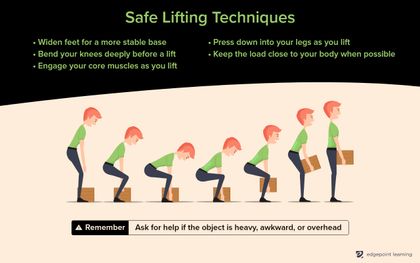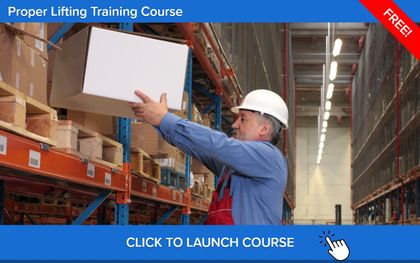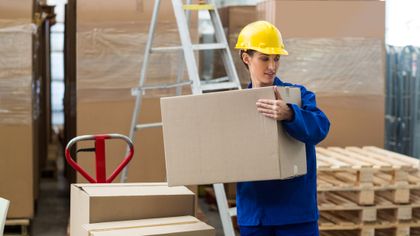How To Create Safe Lifting Training For Employees (And A Free Course!)
Corey Bleich
🍿 5 min. read
Safe lifting training protects all of your employees
Whether you manage a warehouse full of workers or an office full of techies, safe lifting training helps protect your employees from injury. Here’s how (and why) to create a safe lifting training program for everyone. Later in this post, you’ll also find a free safe lifting training online course that you can immediately send to employees who need it most. It only covers the basics, but it's a great place to start if you need to get training out fast.
Why is safe lifting training important?
Almost 34% of workplace injuries occur as a result of lifting and lowering objects. Add this to the fact that 75% of people in the U.S. experience lower back pain at some point in any given year and safe lifting training becomes a priority.
Safe lifting training is exactly what it sounds like. It teaches employees how to safely lift and move objects of varying sizes and dimensions. You may think safe lifting training is just for warehouse workers or the trades but think back to the last time your administrative staff put away a case of printer paper or unloaded even something as light as a box of paper towels. Even light objects, lifted improperly, can lead to injury.
If you have to prioritize training, it’s important to start with employees who lift heavy or bulky objects regularly, of course, but make sure to circle back to all employees at least once a year.

OSHA safe lifting requirements
The Occupational Safety and Health Administration (OSHA) does not have specific safe lifting requirements in terms of how much weight a person may lift (or how often). Instead, they worked with the National Institute for Occupational Safety and Health (NIOSH) to develop a mathematical formula that predicts the risk of injury when lifting.
This safe lifting formula considers factors like:
- How often you lift something
- If you need to bend or twist when lifting or carrying
- The height an object is lifted
- Where the object is being lifted from
- How long the object is held or carried
- How close the object is held to your body
Taking all of these factors into consideration, some types of lifting have more risk. Safe lifting training can help employees assess that risk and take appropriate steps to protect themselves.
What should safe lifting training include?
Five broad topics that should be included in safe lifting training materials across the board include:
- Safe lifting principles
- How to evaluate a lifting task
- Use of mechanical assistance
- Use of personal protective equipment (when needed)
- Long-duration or repetitive lifting tasks
Let's look at these in more detail.
Lifting principles
Safe lifting principles include four subtopics that all require equal coverage:
- Preparation
- Lifting
- Carrying
- Setting down
Each of these subtopics has individual instruction that can be tailored to your particular situation, but the lifting principles remain the same, even in different situations.
For most employees, basic safe lifting techniques can be taught quickly, with simple job aids available for reference as needed. Some of the more important safe lifting techniques include:
- Widen feet for a more stable base
- Bend your knees deeply before a lift
- Engage your core muscles as you lift
- Press down into your legs as you lift
- Keep the load close to your body when possible
- Ask for help if the object is heavy, awkward, or overhead

How to evaluate a lifting task
Employees must know how to evaluate the lifting task before they ever approach the load. This helps them predict their risk of injury to safely implement the appropriate lifting principles or use mechanical assistance.
For example, if you typically store heavy objects overhead, the safe lifting techniques for moving those objects and carrying them across a short distance will be different than if objects are at hip-height or lower. Same goes for object shape, weight, length of carry, and more.
Use of mechanical assistance
Your employees need to know how to use things like hand trucks, dollies, and pushcarts as well as understand when to use them.
Another aspect of this is helping even your strongest employees recognize when the job requires two people.
Use of personal protective equipment (PPE) when needed
Personal protective equipment training is closely linked with safe lifting training.
For example, employees may need to use gloves for better grip or steel-toed boots to protect feet.
Long-duration or repetitive lifting
The longer employees lift and move heavy objects, and the more often they do it, the higher their risk for injury. Their shoulders and lower back are particularly at risk.
Safe lifting training must include the best ways to complete repetitive tasks or lifting for long periods.
Free safe lifting training online
It’s easy to prevent on-the-job injuries with safe lifting training. At EdgePoint Learning, we developed a free safe lifting training online course that is ready to deliver to your employees. While this web-based course just covers the basics, it's a great place to start if you need to get training out fast. We welcome you to share it with your employees.

Looking for a more detailed safe lifting training program for your workforce? EdgePoint Learning can help. Contact us today to learn more about our custom and co-development options, as well as mobile job aids and online learning opportunities.
How to design safe lifting training for your workforce
Safe lifting training is more than just a “one-and-done” proposition. Sure, it’s important to deliver a high-quality onboarding experience that includes safe lifting techniques, but employees need annual training, especially when things change on the job.
A training needs analysis can help you understand what employees need (and who needs it quickly). Once that’s in place, there are a variety of ways to deliver this crucial information to employees.
Consider things like:
- Using geofencing to integrate safe lifting training with location-dependent requirements
- Adding microlearning opportunities in the flow of work to reinforce important concepts
- Incorporating AR-assisted support to demonstrate a safe approach to lifting tasks
- Offering performance support and routine checklists that cover safe lifting principles
These smaller learning opportunities won’t take the place of an annual training refresher, but they keep employees safe every day in between!
Build your safe lifting training program
EdgePoint can work with you to develop your safe lifting training, or we can customize our off-the-shelf training courses for your business. You can also use PinPoint, our precision microlearning app, for your frontline employees. Interested in seeing more of PinPoint's prebuilt content library? Request a demo here.
Still have questions about safe lifting training, or ready to get to work designing yours? Get in touch with EdgePoint Learning today!
